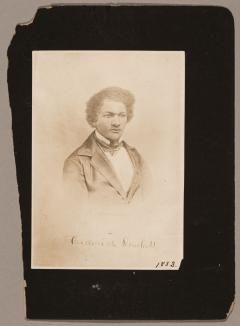A family’s fight for freedom goes on show
Unseen items from 19th century revolutionary, author and activist Frederick Douglass and his family will be on public display for the first time this month.

The exhibition of original manuscript letters, speeches and photographs provides powerful insight into the famous anti-slavery and social justice campaigner’s time in Scotland in the mid-19th century
Douglass was born into US chattel slavery in 1818, meaning he was considered personal property and could be bought and sold as a commodity. He gained freedom in 1838, escaping with the financial support of Anna Murray, a free woman and his future wife.
Sacrifices for justice
The exhibition details his and his family’s sacrifices as they worked in support of all human rights issues in the US and worldwide.
The show is curated by Celeste-Marie Bernier, Professor of Black Studies and Personal Chair in English Literature at the University of Edinburgh.
Dora Petherbridge and Sarah Wilmott at the National Library of Scotland were also involved, with support from Professor Bernier’s colleague Dr Andrew Taylor.
Anniversary exhibition
The items are on loan from the Walter O. and Linda Evans Collection to mark the 200th anniversary of Douglass’ birth.
Dr Walter Evans is a collector and conservator of African American art, history and culture.
The free exhibition - Strike for Freedom: Slavery, Civil War and the Frederick Douglass Family - runs from 4 October 2018 until 16 February 2019 at the National Library of Scotland.
For the first time, Strike for Freedom tells the story of the revolutionary activism not only of Frederick Douglass – world-famous freedom-fighter, liberator and human rights campaigner – but of his family members. Douglass’s wife, Anna Murray, daughters, Rosetta and Annie, and sons, Lewis Henry, Frederick Jr., and Charles Remond all sacrificed everything they had in working towards a ‘new dawn of freedom’.
I am pleased that the letters, papers and photographs from my Douglass collection are being exhibited at the National Library of Scotland. Douglass loved Scotland and I can think of no better place or time to exhibit this material than in Edinburgh on the 200-year anniversary of his birth.
Frederick Douglass was born as Frederick Augustus Washington Bailey. Upon gaining his freedom, his new surname was inspired by Sir James Douglas from Sir Walter Scott’s The Lady of the Lake.
Not alone
The display not only tells the private story of Douglass, but shows that he was not alone in his revolutionary activism. Hundreds of African American radicals and freedom-fighters came to the UK in their lifelong mission to abolish slavery.
Professor Bernier and Dr Taylor have written a book based on items from the collection and the life of the Douglass family. If I Survive is published by Edinburgh University Press.
Black History Month
The exhibition coincides with Black History Month, a national celebration of the individuals and events which have shaped African and Caribbean communities through history and today.
The University and the Students’ Union is hosting a number of events to raise awareness about black communities’ contributions to modern Britain and around the world, as well as facilitate discussion about the ongoing challenges they face.
University staff and students are encouraged to take part in a range of activities including free walking tours, workshops and panel events.

